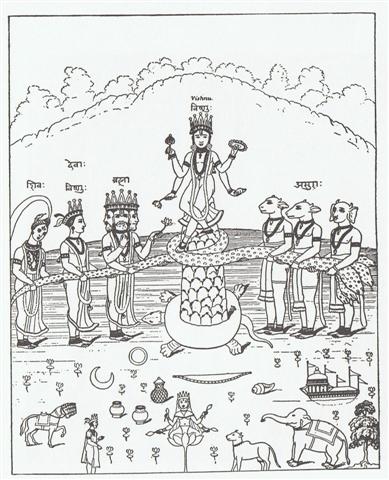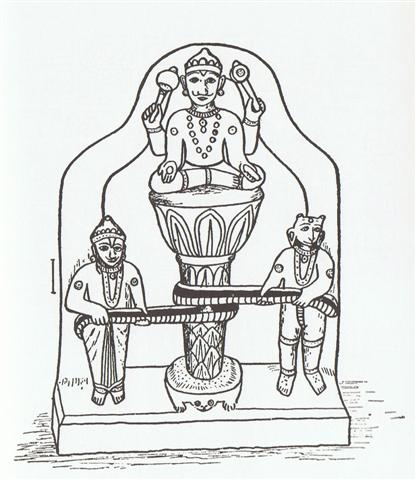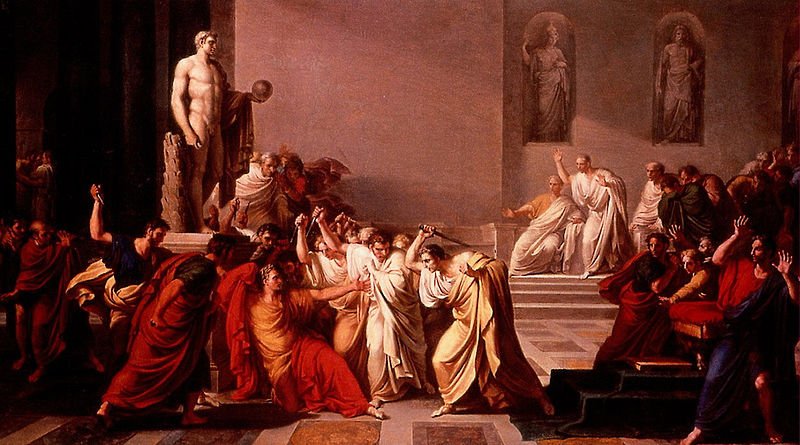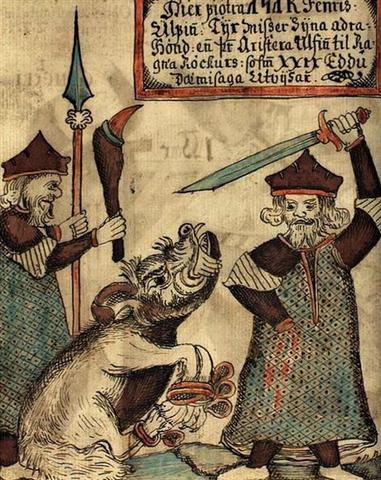Then came the 4th (unlucky) place at twice
54:
... Interestingly, since
another meaning of shi is 'death',
the number 4 is considered unlucky. For
example, the floor numbering in hotels
sometimes jumps mysteriously from 3 to 5; it
is also considered unlucky to give four of
something as a present ...
108 (= 4 * 27 = 472 - 364 = 4 * 118 - 4 *
91) was well known anciently:
| ... It is
known that in the final battle
of the gods, the massed legions
on the side of 'order' are the
dead warriors, the 'Einherier'
who once fell in combat on earth
and who have been transferred by
the Valkyries to reside with
Odin in Valhalla - a theme much
rehearsed in heroic poetry. On
the last day, they issue forth
to battle in martial array. Says
Grimnismal (23): 'Five
hundred gates and forty more -
are in the mighty building of
Walhalla - eight hundred
'Einherier' come out of each one
gate - on the time they go out
on defence against the Wolf.'
That makes 432,000 in all, a
number of significance from of
old. This number must have had a
very ancient meaning, for it is
also the number of syllables in
the Rigveda. But it goes
back to the basic figure 10,800,
the number of stanzas in the
Rigveda (40 syllables to a
stanza) which, together with
108, occurs insistently in
Indian tradition, 10,800 is also
the number which has been given
by Heraclitus for the duration
of the Aiōn, according to
Censorinus (De die natali,
18), whereas Berossos made the
Babylonian Great Year to last
432,000 years. Again, 10,800 is
the number of bricks of the
Indian fire-altar (Agnicayana).32
32
See J. Filliozat, 'L'Indie et
les échanges scientifiques dans
l'antiquité', Cahiers
d'histoire mondiale 1
(1953), pp. 358f.
'To
quibble away such a
coincidence', remarks Schröder,
'or to ascribe it to chance, is
in my opinion to drive
skepticism beyond its limits.' 33
33 F. R. Schröder,
Altgermanischer Kulturprobleme
(1929), pp. 80f.
Shall one
add Angkor to the list? It has
five gates, and to each of them
leads a road, bridging over that
water ditch which surrounds the
whole place. Each of these roads
is bordered by a row of huge
stone figures, 108 per avenue,
54 on each side, altogether 540
statues of Deva and Asura, and
each row carries a huge Naga
serpent with nine heads. Only,
they do not 'carry' that
serpent, they are shown to
'pull' it, which indicates that
these 540 statues are churning
the Milky Ocean, represented
(poorly, indeed) by the water
ditch,34 using Mount
Mandara as a churning staff, and
Vasuki, the prince of the Nagas,
as their drilling rope.
34 R. von
Heine-Geldern, 'Weltbild und
Bauform in Südostasien', in
Wiener Beiträge zur Kunst- und
Kulturgeschichte 4 (1910), p. 15.
(Just to
prevent misunderstanding: Vasuki
had been asked before, and had
agreeably consented, and so had
Vishnu's tortoise avatar, who
was going to serve as the fixed
base for that 'incomparably
mighty churn', and even the
Milky Ocean itself had made it
clear that it was willing to be
churned.)

The
'incomparably mighty churn' of
the Sea of Milk, as described in
the Mahabharata and
Ramayana. The heads of the
deities on the right are the
Asura, with unmistakable
'Typhonian' characteristics.
They stand for the same power as
the Titans, the Turanians, and
the people of Untamo, is short,
the 'family' of the bad uncle,
among whom Seth is the oldest
representative, pitted against
Horus, the avenger of his father
Osiris.

The
simplified version of the
Amritamanthana (or Churning of
the Milky Ocean) still shows
Mount Mandara used as a pivot or
churning stick, resting on the
tortoise. And here, also, the
head on the right has
'Typhonian' features. The whole
of Angkor thus turns out to be a
colossal model set up for
'alternative motion' with true
Hindu fantasy and
incongruousness to counter the
idea of a continuous one-way
Precession from west to east
... |
They went on defense against the Wolf.

This strange beast came, according to the
Chinese, 10 days after the Wall and 16 days
before the Dog:
... At
the beginning of 44 B.C. -
when Ceasar was still alive
- the Senate decided to
raise statues of him in all
the temples and to sacrifice
to him on his birthday in
the month Quintilis,
which in honour of him was
renamed July. He was raised
to the status of a god
(among the other gods of the
state) under the name
Jupiter Julius. Marcus
Antonius, who this year was
consul together with Caesar,
became high priest and
responsible for the
ceremonies. In the middle of
February, at the time of the
old feast of Lupercalia
[Lupus = Wolf], he
ran around naked and whipped
the Roman ladies with thongs
made from goat-skin [februa],
in order to promote their
fertility
...

... The
brutes of spring caused the
downfall of both Captain
Cook and Julius Caesar.

|
Egyptian bread,
(-t,
female
determinant) |
 |
Phoenician
qoph |
 |
Greek
phi |
Φ(φ) |
|
... is the 21st
letter of the
Greek alphabet
... Its origin
is uncertain but
it may be that
phi originated
as the letter
qoppa ... In
traditional
Greek numerals,
phi has a value
of 500 or 500000
...
Isaac Taylor,
History of the
Alphabet:
Semitic
Alphabets, Part
1, 2003:
'The old
explanation,
which has again
been revived by
Halévy, is that
it denotes an
'ape,' the
character Q
being taken to
represent an ape
with its tail
hanging down. It
may also be
referred to a
Talmudic root
which would
signify an
'aperture' of
some kind, as
the 'eye of a
needle,' ...
Lenormant adopts
the more usual
explanation that
the word means a
'knot' ...

... The king,
wearing now a
short, stiff
archaic mantle,
walks in a grave
and stately
manner to the
sanctuary of the
wolf-god
Upwaut, the
'Opener of the
Way', where he
anoints the
sacred standard
and, preceded by
this, marches to
the palace
chapel, into
which he
disappears. A
period of time
elapses during
which the
pharaoh is no
longer manifest.

When he
reappears he is
clothed as in
the Narmer
palette, wearing
the kilt with
Hathor belt
and bull's tail
attatched. In
his right hand
he holds the
flail scepter
and in his left,
instead of the
usual crook of
the Good
Shepherd, an
object
resembling a
small scroll,
called the Will,
the House
Document, or
Secret of the
Two Partners,
which he
exhibits in
triumph,
proclaiming to
all in
attendance that
it was given him
by his dead
father Osiris,
in the presence
of the earth-god
Geb. 'I
have run', he
cries, 'holding
the Secret of
the Two
Partners, the
Will that my
father has given
me before Geb.
I have passed
through the land
and touched the
four sides of
it. I traverse
it as I desire.'
...
.jpg) |
We are
close to the key myth of
mankind, that which explains
the regeneration of sun and
of growth. Once at least
some people kept the
tradition living. I became
interested in what really
happened at March 15 and
reopened Henrikson to find
out: Caesar was forewarned
of the threat by the prophet
Spurinna, who told him that
a great threat was coming at
Idus Martiae
or just before [i.e. at
3-14]. The day arrived and
Caesar was still living. He
was walking to his meeting
with the Senate when he
happened to encounter
Spurinna and told him
jokingly that he was still
alive. Spurinna calmely
answered that the day had
yet not ended. The Romans
divided their months in two
parts and the dividing point
was Idus, which in
some way was connected with
full moon. March 15 was the
midpoint of March, which is
close to spring equinox. The
old agricultural year
defined the beginning of the
year to the time when sun
returned, and it was
connected with Mars
...
... The
chaotic tumult in the
Curia (where the Senate
had their meeting and where
they killed Caesar) resulted
in his dead body being left
lying on the floor, while
all the Senators panicked
and ran out through the
doors in different
directions. They had planned
to throw his body into the
river, but the time of plans
and order was in the past.
Instead, in the afternoon,
three of the slaves of
Caesar came and fetched his
body, and carried him on a
stretcher to his home south
of Forum - and one arm was
hanging down in the corner
where the 4th slave should
have been ...

|










.jpg)
